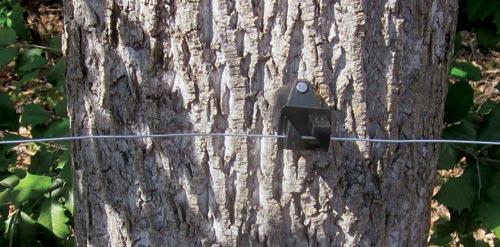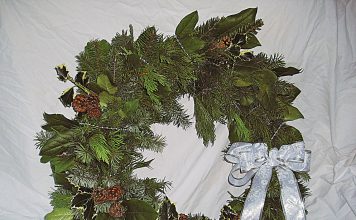 |
|
| Issue #147 • May/June, 2014 |

A new electric fence attached to older traditional wood fencing
More and more people are turning to electric fences as the cost of standard metal and wood fencing continues to climb each year. Those who are concerned about the reliability of the electric grid are turning to solar-powered electric fencing.
Traditional fences are nothing new to a life-long farmer or cattleman. Large-scale cattle ranchers and farmers are very familiar with installing and maintaining all types of fencing. However, the weekend farmer may not have the experience, special tools, or power equipment required to install traditional fencing. Not only is electric fencing much less expensive than traditional wood or metal fencing, but it can be installed with a minimum amount of tools and little or no prior experience.
Why fence?
Any gardener soon learns the importance of fencing after the garden they spent months cultivating is destroyed in one night by groundhogs or deer.
Fencing is not only used to keep wild animals from getting in, but is also used to keep domestic animals from getting out. Temporary fencing is normally used to section off small grazing areas inside larger fenced acreage to rotate pastures and keep cattle out of cultivated areas. Taller fencing is used to keep high-jumping animals like horses and deer from sailing over, while lower but more substantial fencing may be used to keep bears out of a beekeeper’s hives. Metal fencing with closely-spaced wires is used to keep smaller animals like rabbits or goats out of a vegetable or herb garden. In other words, the type of fencing you need depends entirely on what you are trying to keep in or out. These considerations should be the most important concern when buying fencing, not what’s on sale or available locally.
Before getting into a detailed discussion about installing your own solar-powered electric fencing, perhaps a brief review of fencing basics will be helpful to those who are new to the subject.
General guidelines

Temporary electric fencing using removable plastic fence posts
In this brief overview of electric fence installation, I’ve included many suggestions and installation tips. However, it is still necessary that you follow all manufacturers’ installation instructions, and comply with all state and county regulations governing the proper installation and use of an electric fence in your area. It’s not uncommon for local codes to require distinctive warning signage or other installation requirements.
The first thing to understand about a properly installed electric fence is that it does not harm the animals (or people!) that happen to rub against the energized wires. After any new electric fence installation, you should first entice your animals or pets to approach the fencing. This is usually accomplished with food placed on the opposite side of a new fence as a training exercise. After one or two attempts, most animals quickly recognize the need to stay clear of an electric fence and are then able to be safely moved into a larger pasture protected by electric fencing. Although an electric fence only consists of a few bare wires strung between some lightweight insulator supports, it’s their learned fear of a fence they recognize and not the strength of the wire that keeps an animal contained.
The next important consideration is deciding how many strands of wire you will need, and determining what distance apart should they be spaced. I am sure readers with prior experience with electric fencing will have their own installation guidelines that worked best for them, but what follows are generally accepted installation directions supplied by multiple electric fence manufacturers.
Most animals making initial contact with an electric fence will immediately back up if this contact is near the front of their face. In this case a grazing animal like a cow may make initial contact when their nose touches an energized wire near the ground. However, if the energized wires are spaced too far apart, it may be possible for a cow or horse to extend their head through to the other side of the fencing before their neck touches one of energized wires. When this occurs, the startled animal thinks something unpleasant just happened behind them and is more than likely to bolt straight through the flimsy wires, no doubt dragging a large section of your new electric fence along with it. This is why initial training is important. You want the animals to learn to recognize an electric fence and know to stay clear.
While bare wire for electric fencing comes in various sizes and different metals, it still is hard to see. Lower-cost electric fences or temporary installations may use the less expensive 17-gauge galvanized steel wire, but permanent electric fencing usually consists of heavier 14- to 16-gauge aluminum wire, which is stronger and will not rust.
While more expensive than bare wire, some electric fence wire is “woven” into a brightly-colored flat tape or rope, which makes it easier for the animals to see and remember what happens when they get near. This woven fencing consists of multiple tiny aluminum wires, high-strength fiberglass, and special UV sunlight protection. It is available in ½” to 1½” widths. Yellow and black or all white fencing tape colors are ideal for temporary fencing that is moved regularly, since it is easier for the animals to see where the electric fence is currently located.
If any object, fence post, or tall weed comes in contact with the electrified fence wire, it can significantly lower the shock value, and possibly even short all of the voltage to ground. If this happens, the entire fence will lose its ability to contain your animals. Therefore, it’s important to walk your fence line regularly and keep all weeds and tall grass at least five feet away from both sides of the fencing.
Hand-held testers are available that allow a quick test of the electrified fence anywhere along the entire length. Lower-cost units utilize a stacked group of small neon lamps that illuminate in steps based on the level of voltage detected. Higher-cost units may include a digital readout of voltage levels. A standard volt-meter will get damaged if used to check electric fencing, since fence voltages are typically more than 5,000 volts. Most electrical wire sold by builder supply outlets rarely has an insulation covering that is sunlight-resistant and rated for higher than 600 volts, making this wire unsuitable for connecting the fence energizer to the fence wires. The voltage output of an electric fence energizer is just like the voltage supplied from a car’s distributor to the spark plugs, and spark plug wires have very thick insulation to prevent arcing and shorts.

Standard wire insulator with attached nail designed for trees or round posts
Sizing fence energizers
Comparing different brands of electric fence energizers can be confusing since there are few rating standards. Some units are advertised as having a 5,000-volt output, while other energizers may advertise their output in “joules.” Some brands advertise how many fenced acres their unit can power, while others advertise their output in miles of fencing.
The best measurement of any electric fence energizer is how many joules it generates. A joule is the international term for measuring energy, much like the kilowatt-hour (kWh) is used in the United States to measure energy. However, the main difference is the unit of time each uses. A joule equals one watt per second (not watt per hour). While a solar fence energizer with a rating of two joules might appear to be a small number, this output level can easily energize several miles of fence wire. Although my solar fence charge supplies less than two joules of energy, this is more than enough high-voltage charge to make you wish you never touched the fence.
The largest off-the-shelf fence energizer I could find locally had a rating of just over six joules, and was advertised to power 100 miles of fence wire. I don’t know about the fencing experience of large ranchers, but I would rather utilize several smaller energizers instead of placing my entire fencing system on a single energizer. If this unit failed, all 100 miles of fencing would become instantly useless. If your fence requires five strands of wire, a 100 mile “fence wire rating” would actually mean a fence 20 miles long (100 miles/5 wire strands). Using multiple energizers, any single failure would mean only one of the fenced areas would become non-energized.
Using a 120-volt AC fence energizer could be a problem on very large fencing systems since utility power outlets may not be available at other locations around the fence line. This is the main reason to consider multiple smaller fence energizers powered by their own solar-charged battery. These units can be located at multiple points around your property without concern for what happens if the utility grid goes down.

Wire insulator with attached nail designed for square wooden fence posts
Solar fence energizers
Many people do not want to deal with batteries and opt for a standard 120-volt AC fence energizer. For those of you who appreciate the benefits of a totally off-grid lifestyle or are concerned about the reliability of the utility grid, a solar-powered fence energizer may be the best solution. These units typically come in two different designs, one with a built-in battery, and one using a separate external battery.
Self-contained solar-powered fence energizers have a small internal battery and a small solar module attached to the top of the unit. Some people with battery energizers use a car or truck battery for power, and periodically travel around the fence line to switch out the recently discharged battery with a fully-charged battery they carry to the site. This is far too much work for me, so I use a separate solar module and solar charge controller to keep my larger external battery fully charged.
I found that the fence energizers designed for connection to an external 12-volt battery were almost half the cost of the energizers that included a small built-in solar module and internal battery. This price savings helps offset the added cost of buying a larger external battery, solar charge controller, and solar module. Not only does this approach allow the use of a wider selection of solar modules, but the larger battery provides many more days of stand-alone operation during extended periods of bad weather. However, even those self-contained fence energizers with small internal batteries are still advertised to operate a week or more with no sun.

Low-cost electric fence wire insulator supports are available for every type of mounting requirement
Part of the reason for the longer battery life of a fence energizer is that their high-voltage output is “pulsed” on and off each second rather than staying on continuously. While this cycled off period may not seem like it would provide much of an energy savings, it does allow time for the control circuits to ramp up the small 12-volt DC battery voltage to more than 5,000 volts and then discharge in short electrical bursts. In addition, this pulsing effect provides more shock value to an animal in the form of multiple “strings” rather than a single continuous voltage discharge.
Grounding
Probably one of the most neglected areas of electric fence installation is “grounding” the system. Any time an animal comes in contact with an energized fence wire, they are completing an electrical circuit. High-voltage electricity at a very low current leaves the positive (+) terminal of the fence energizer and travels along the fence wire which is supported by electrical insulators. This electrical energy then travels along the surface skin of the animal from the point of contact with the energized fence and then down to their foot or hoof and into the ground. This high-voltage and low-current electrical flow then travels through the earth all the way back to two or more ground rods driven into the ground near the solar-powered energizer. This electrical energy then travels through the connecting wire from these ground rods and up to the negative (-) post on the solar-powered fence energizer, completing the electrical circuit.
Fenced areas where the surface of the ground stays fairly damp year-round may allow utilizing only one ground rod, but most locations will require two or more ground rods for proper operation. These ground rods are the same as those sold for grounding home electrical services and usually consist of a copper-clad steel rod 1/2″ in diameter and driven six to eight feet into the earth.
Multiple ground rods must be spaced at least 10 feet apart, wired together, then wired back to the energizer. Never locate ground rods near underground electrical services, phone lines, metal water pipes, or other ground rods connected to different electrical systems. If this happens, animals could be shocked when touching a metal drinking tank. This can also cause noise or interference in nearby phones and radios. You should never route electric fencing parallel to or near high-voltage power transmission lines, as these can induce electrical energy into the fence wiring and destroy your fence energizer.
If you are located in a geographic area having very limited rainfall or perhaps suffering through an unseasonably dry summer, you can significantly improve the performance of any electric fence by increasing the soil conductivity around the ground rods. By filling an old five-gallon plastic paint bucket or soft drink bottle with water and punching a tiny hole near the bucket bottom or bottle cap, the resulting slow water drip will keep the soil damp around the ground rod. Depending on the size of the container and rate of water drip near the ground rods, you may be able to go several days at a time between adding more water.
Lightning is one of the main reasons an electric fence energizer gets damaged. If you are in an area with a high potential for lightning strikes, you may want to add one or more lightning arrestors to your energized electric fence. One terminal in this small device is connected to each bare wire in an electric fence, with a second terminal connected to a nearby ground rod. If there is a lightning-induced voltage spike traveling along this fence wire, the lightning arrestor will divert this excess energy into the ground rod and away from the fence energizer. This can significantly reduce the risk of lightning damage to your electric fence.

Electrical path during a shock
Electric fence installation
The installation of an electric fence is very straightforward once you have selected the type of fence wire or woven tape you plan to use. Each type of fencing material has an amazing selection of low-cost devices intended to make installation easy and fast. Other than a good set of fence pliers and a wire barrel crimper, this is all you need for most electric fence installations.

Basic fence installation tools include a wire barrel crimper,
fence pliers, and electric fence tester.
Coils of electric fence wire continuing a mile or more are not uncommon on long fence installations these can be very heavy to lift. There are several types of extension handles and un-spooling devices available that allow dragging or rolling the wire spool across the ground behind you or your ATV. If you will be attaching your electric fence wire to a row of trees, wood fence posts, metal “T” bar fence posts, or all-plastic temporary posts, there are very low-cost insulators designed for each specific type of post.
Plastic insulators that include an attached nail to drive into a wood post or tree are typically sold in bags of 50 for less than $10 and can be installed as fast as you can drive a nail. Some plastic insulators are designed to “twist” onto metal “T” rails or rods which is easy and fast. Low-cost insulated handles with an internal tension spring are available to make access points or gates, along with insulators designed for turning corners or ending a fence run. Multiple fence wires are interconnected electrically to each other using pre-made electrical wire jumpers. All sizes and types of crimp-on connectors are available to make wire splices fast and reliable.
Gates
There are several ways to deal with access through an electrified fence. The easiest method is to add a low-cost insulated gate handle as mentioned earlier. This insulated handle uses an internal tension spring to keep the electrified wire tight across the opening between two posts. Each energized wire can be safely disconnected from a hook at one end using the insulated handle to allow you to pass, then reattach without having to walk back and turn off the energizer.

Use crimped barrel fittings for all wire splices so there will be no loss of electrical contact due to corrosion, which is not the case when wires are just twisted together
For more permanent metal or wooden hinged gates, the electric circuit can be carried between the electric fence sections on each side of the gate using an insulated interconnect cable. This insulated cable is usually installed in flexible hose running under the walk or drive. However, due to the higher potential for being shorted by low-lying water, I prefer to carry the insulated interconnecting wire up and over the gate or driveway without any breaks or disconnects. Obviously, you want to make sure the raised supports will keep this energized wire above the maximum height of people or vehicles that may pass through any gate.
Using solar power
First, select the fence energizer sized for your specific needs. My energizer (rated slightly over one joule) cost $100, but you may find a sale when suppliers want to move out the old designs to make room for newer models. Larger units with a rating of five to six joules will cost more than $300, so make sure the unit you select is adequate for your needs, but not too large. Unless you are trying to fence in your entire county, I think you will find a unit rated for two to three joules should meet all but the longest fencing requirements.
Since a solar-powered fence energizer is not tied to a utility outlet, if your fencing requirements exceed a mile or more, it may be more cost effective to utilize several small electric fence energizers, with each powering a separate section of fencing. Never attach more than one fence energizer to the same section of fence wiring. You will want to electrically isolate each run of fence when using multiple energizers.

Solar module facing south with tilt angle equal to site latitude, fence energizer, and battery housing
Make sure the fence energizer you purchase is intended for 12-volt DC power with an external battery if you plan on assembling your own custom solar-powered system. A standard RV/marine battery will provide far more days of operation with no sun than a smaller internal battery. These deep-cycle batteries are designed for continuous charge/discharge cycling and are usually available locally. Most car batteries have much thinner plates to reduce weight and are not designed for daily charge/discharge cycling. Car batteries should not be used to power an electric fence energizer as they will have a very short life.
I prefer using a sealed gel-cell battery instead of a “wet cell” battery, but these are more expensive and usually must be custom ordered. Since they are totally sealed, they can be mounted in any position so there is no danger of an animal tipping one over and spilling liquid acid.
When you select a solar module to keep your battery fully charged, make sure it is rated for 12 volt battery charging. Typically it will have a 16 to 17 volts DC “open circuit voltage” rating listed on the nameplate. While the actual amp-hour load for a fence energizer is rarely provided in the advertizing or owner’s manual, a solar module in the 10 watt range should be able to keep a one joule rated energizer battery fully charged, while a six joule rated energizer will require a solar module rated at 60 watts or higher, depending on your local weather conditions.
Being able to mix and match separately-purchased solar modules and external batteries can result in much better performance than a self-contained solar fence energizer with limited internal space for a battery and a small surface area for the solar module.

View inside metal enclosure showing 12-volt battery, fuse, and solar charger
Testing
After you have installed your electric fence wire, ground rods, and solar-powered fence energizer, it’s time to test. As mentioned earlier, this is best performed using an electric high-voltage fence tester. These typically cost about $10, which is cheap insurance to keep your valuable animals from heading to town. As you walk along your fence line, check the output of each wire and note any section of wire that is not energized or shows a low-voltage level. This tester includes a ground-probe about the size of an ice pick at the end of an attached cable that is pushed into the ground near where you are testing the fence voltage.

Hand-held high-voltage fence tester
Make sure there are no tree branches or tall grass touching the wires, as these can easily drain off a significant level of voltage. While it is understood that the voltage will drop as you move further and further away from the fence energizer, you should still measure at least 3,000 volts at the extreme end of a long fence run when using a fence energizer with a 5,000-volt output rating.
If this voltage loss is too high and you have verified there are no places where the wires are being shorted to ground, you may need to use a larger-gauge wire which will have a lower electric resistance. If this is not possible, you will either need to use an energizer with a higher joule rating, or divide the fencing into separate electrically-isolated circuits and utilize multiple solar-powered energizers.
Closing comments
Never rely totally on any electric fence for perimeter fencing or to keep valuable animals away from dangerous cliffs, highways, or bodies of water. You should still use traditional metal or wood fencing for property boundaries, and use electric fencing for internal division of pastures and farmland. A solar electric fence energizer with reusable plastic posts is perfect for portable or temporary fencing needs.
Also remember to follow all installation guidelines given for your specific animal or pets. Using too few wire runs or spacing wires too far apart may allow a large animal to become entangled by a poorly-installed electric fence. You should use brightly-colored plastic flagging or signage to let people know they are approaching an electrified fence. Finally, remember to check the entire length of all electrified fencing on a regular basis using a tester to verify the system is working properly.

Wiring diagram
[weaver_widget_area id=’articles_about_yago’ class=’text3′]















the world is moving towards sustainability and solar is one of the best form of sustainable resources. But not a lot of products can be run on solar power such as electric fencing. These fences are a remarkable product which is environment friendly. love it.
My fence wire tape doesn’t register any voltage in the wire when the energizer is switched to charging. Is this normal?
Yes as long as the chicken wire doesn’t ground anywhere and your charger can handle the load.
I have no clue how much power chicken wire will pull but I would assume it’s similar to poultry netting. Also your wire will need to be a conductive metal.
Anything you use as your live or power wire (your chicken wire) can not touch anything that goes to ground like vegitation or wooden posts that become conductive when wet. Your power will leak righ out of the fence wire. If the chicken wire is insulated and not touching anything, then yes It could be used. Any grass,vegitation or earth leaks will flatten the battery from the solar pretty quickly.
Can chicken wire be used with solar power